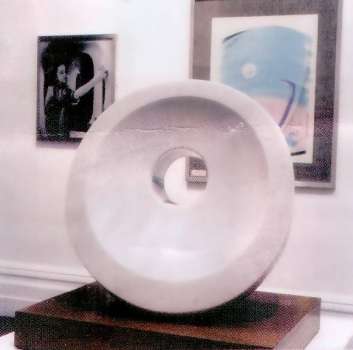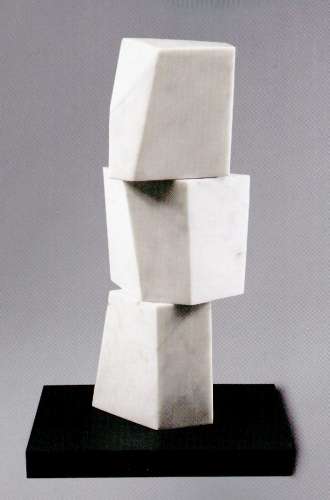
Constellation 1973
The Finale
I think that Hepworth's journey and development changed from the sculptor inside, exploring the landscape, to the spectator of the landscape, the sculptor looking onto the landscape as opposed to looking out form the landscape. Her later forms are more formulated; I think this is partly a factor of the heavy reliance on assistants but also an evolution towards the perfection of her own sculptural language.

Constellation 1973
Plymouth Museum and Art Gallery's Hepworth, Constellation 1973, consists simply of a cylinder of marble pierced by a hole, tiled upwards, with a hollow on the upwardly facing plane. Although it appears simple closer inspection reveals more subtle detail. I think the later forms communicate her ideas, inorganically, and precisely.
Her ideas such as those who lead to the formulation and realisation of Sculptures Such as the Family of Man 1970, Conversation with Magic Stones 1973 BH567 and Assembly of Sea Forms 1972 BH555 (below), show that both the experience of using and adapting materials and communicating though abstract form, became highly developed. This meant that her creative force, translating feeling and experience of landscape was absolute to the end.

Assembly of Sea Forms 1972 BH555
Her death in a fire at her home and studio, although sudden ended both her creative and mortal life. Although she had suffered from periods of illness over the last 10 years of her life, I think her final years producing sculpture were as exciting as any other period in her career, she expressed new ideas, though existing methods, an example would be, The Family of Man 1973, although related to the presence and effect of human influence upon the landscape, it employed differing ideas other from her traditional repertoire of landscape sculpture. Her willingness to experiment with new ideas and different subjects kept work though-out her career fresh and dynamic.

Construction (crucificion) 1966 BH443
Although (from what I have read about her principals and behaviour) she many have preferred the high-brow, academic, recognition by institutions and collectors to the naive misunderstanding of her work often reported in the contemporary press of the day (which often upset her). I think her work has been best described by Alan Yentob in the Imagine programme on her work, "although her work is abstract it is not hard to enjoy".

The Last Catalogued Barbara Hepworth Sculpture:
Small One, Two, Three (Vertical), 1975 BH579
My study of her work has led me to admire her achievement. Although the conduct of her personal life is often criticised I think her willingness to make her sculpture the centre of her life, enabled such a comprehensive career. This choice by an artist is what we should look for when questioning the integrity of any new artists work. Every work by Hepworth appears full and finished because of this. As for the term "sculptress", and the feminist views on her work, that (I think) only seek to lessen this integrity (her work never involved such themes).